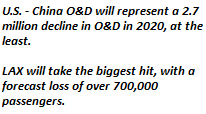Before we start with the Monday Update… Announcing!
Jude Bricker – CEO of Sun Country To Present
At The International Aviation Forecast Summit
The International Aviation Forecast Summit is the event that delivers over-the-horizon perspectives of the future of aviation… perspectives that give our attendees the competitive edge.
That competitive edge will be honed further with an incisive session featuring Mr. Jude Bricker, CEO of Sun Country Airlines.
 Widening its aviation footprint, Sun Country has announced that in addition to a growing ULCC network, it will be also operating freighters for Amazon. This is a new type of business plan, and one that gives the airline a much wider revenue footprint.
Widening its aviation footprint, Sun Country has announced that in addition to a growing ULCC network, it will be also operating freighters for Amazon. This is a new type of business plan, and one that gives the airline a much wider revenue footprint.
Mr. Bricker joins the exciting line-up of aviation industry leaders that will be delivering their views of the future. At the IAFS, the focus is not on pre-determined “panel discussions,” but on exploring what these executives see ahead.
Standby For Traffic, Fleet & Trend Forecasts, Too. There are a few giant monkey wrenches that might – might – affect air transportation domestically and globally in the coming 36 months, and they’re going to be reviewed at the IAFS. Like, the effects of new-generation, multi-mission narrow-body platforms on airline route planning. The return of the 737 MAX. Plus, a lot of unknown factors… if the current coronavirus epidemic continues to spread in China and globally, airline travel will be materially affected. The IAFS forecast sessions are known for identifying emerging trends.
Special Early Registration Rates. Register now, and take advantage of low New Year registration rates through January 30. If you can attend only one event in 2020, this is the one that delivers information, forecasts and perspectives no other event comes close to.
Click here now, and get a jump on the future!
______________________
China – U.S. Traffic: All Bets Are Off
Matter of Fact, The Casino May Get Shuttered
Occasional cases of the potentially deadly coronavirus are being discovered all over the world, including in the USA.
But it’s now all across China. In a big way.
As it appears now, it is spreading quickly… and is worse than publicly conveyed in China, where there are private videos of folks collapsing in the street, and ambulances taking people to overcrowded hospitals.
As of today, the virus has spread from its start in the city of Wuhan to every province in China.
Official numbers are now indicating over 2,500 cases. Based on the reliability of government actions in China, you would be safe to quintuple that number.
Revisiting Traffic Forecasts
China-US air traffic represents approximately 7.08 million annual O&D.
Or, at least that’s what it was forecast to be in 2020, until now. Airports:USA® and Airports:China™ data are now being revised to reflect the expected effects on U.S.- China air traffic.
They are not comforting and they may not be short term.
As of today, and depending on the developments in China, between January and June, we are forecasting at least a 75% drop in passenger traffic between the USA and China. Severe, but based on current understanding of the situation in China, it may even be optimistic.
 When the real facts are known about this virus, and how it is spreading, nobody awake and sober is considering a leisure trip to anywhere in the Middle Kingdom.
When the real facts are known about this virus, and how it is spreading, nobody awake and sober is considering a leisure trip to anywhere in the Middle Kingdom.
PRC government is massively and belatedly trying now to deter travel within the country, even up to the point of putting up roadblocks between provinces.
As a preventative measure, it’s a lost cause, due to their inaction and attempts in the early stages to deny the outbreak. We’ll touch on that later.
Millions of people have skidaddled out of Wuhan, the epicenter of the outbreak, long before the government’s attempts to prevent such movements, and long after the government knew about the virus.
On one hand, it is Spring Festival, the Lunar New Year, when travel in China represents the biggest human migration on earth. Trains are packed, busses, too. Airports are crowded. A perfect situation to quickly spread a contagious disease.
On the other hand, there were lots of people in Wuhan aware of the expansion of the coronavirus, and they wanted to get out of Dodge, too.
Some Preliminary Traffic Numbers
At least for the next six months, flights between China and the USA are going to be financial disasters.
And some U.S. gateways are going to take some hits, too.
As of today, the Airports:USA® forecast for SFO indicates a loss of at least 344,000 O&D through June, as a result of the expected collapse of traffic to and from China.
At LAX, the estimate is 702,000 O&D reduction. Not lethal to LAWA, but still a significant financial bang.
Air Service Cuts Inevitable
Furthermore, we can expect to see Chinese carriers quickly cut flying to the U.S. – on a “temporary basis.” In particular, service to any second-tier  Chinese destination is likely on the near-term chopping block.
Chinese destination is likely on the near-term chopping block.
We can even expect to see a couple of Chinese carriers drop out of the U.S. market. One to watch is Hainan, whose load factors are almost uniformly below the 83% China-US average.
#1 Preventative Measure – Stay Away
Already, US carriers are taking precautions. One airline has issued masks to flight attendants on flights to and from China.
Sounds great… except the paper masks we see people wearing across China don’t do diddly to prevent spread of disease. They do a great job of keeping the wearer from drooling on other people, but viruses can get in easily.
 The masks that do have some effect – called N95 respiratory masks – are only effective when worn constantly, are not removed and only for short periods. The point is that in any close quarters, the coronavirus can be transmitted.
The masks that do have some effect – called N95 respiratory masks – are only effective when worn constantly, are not removed and only for short periods. The point is that in any close quarters, the coronavirus can be transmitted.
Oh, and you probably can’t buy N95 masks, anyway. Take a look on Amazon… in just about all cases they are “temporarily unavailable” – speculators have scooped them up, probably.
Actually, U.S. carriers may have to completely re-think China flying for the near term. Beijing and Shanghai are no longer outside of the reach of the coronavirus.
Out of Control. Because Denial Was The First Step
A little context to this situation…
The coronavirus now spreading across China – and maybe the globe – is believed to have started in a typical and filthy “wet market” in Wuhan, which is a large city in central China.
A wet market is a place where all sorts of food – meat, fish, birds, snakes, poultry are sold under incredibly unhygienic conditions. No refrigeration. Meat sitting out all day, pawed by vendors that don’t wash hands, and by shoppers. Flies and other insects are rampant.
Some misguided folks have lauded China for taking “quick action” to contain the virus. Flat wrong. The first actions were apparently to try to make it appear that there was no problem, and only when the virus started to appear around China from people traveling, did government entities “take action.”
 One example is the grand neighborhood Spring Festival meal that was put on for over 100,000 people, all partaking together of a huge communal repast. To show that there was no problem, it was right in Wuhan, and only four miles from the place the epidemic was generated.
One example is the grand neighborhood Spring Festival meal that was put on for over 100,000 people, all partaking together of a huge communal repast. To show that there was no problem, it was right in Wuhan, and only four miles from the place the epidemic was generated.
Worse, it was held days after the epidemic was known and was spreading. There were at the time 56 reported cases of the disease – and, being “official” data, you can at least double the number.
But the people in charge did not want the news of the potential virus to get out. So they covered it with big news on events such as the 40,000 families attending a shindig. Epidemic? What epidemic?
Later, the decision was made to quarantine all of Wuhan. Close the airport, cancel the trains, shut down the bus systems. Great. But they gave the populace 8 hours of warning first. Exodus to the rest of China, and quick.
Bottom line: The growth in China-U.S. traffic is on hold – how long will depend on how much this epidemic expands in China and globally.
A virus loves to have people in close quarters.
That defines an airplane cabin. Threat noted.